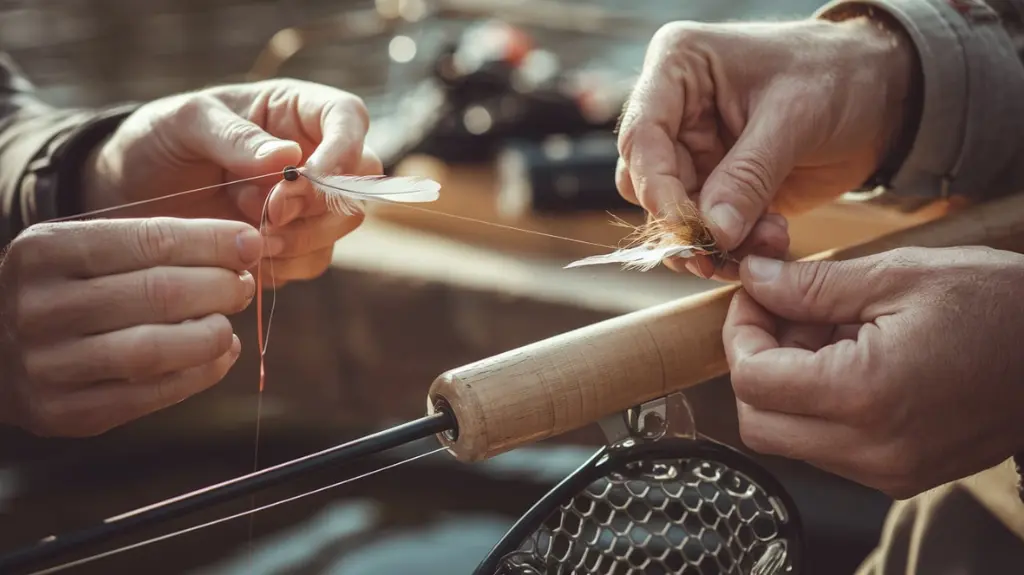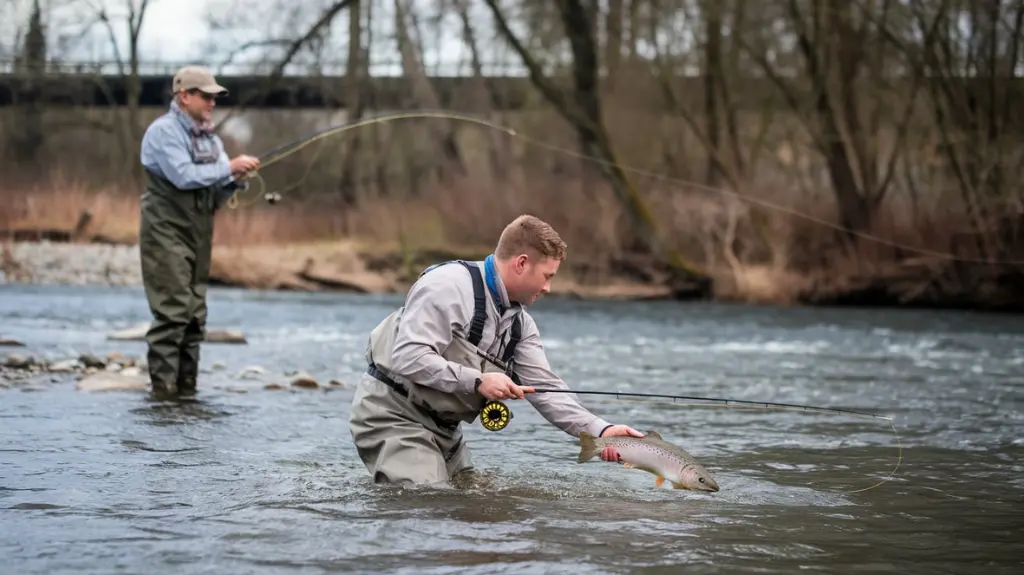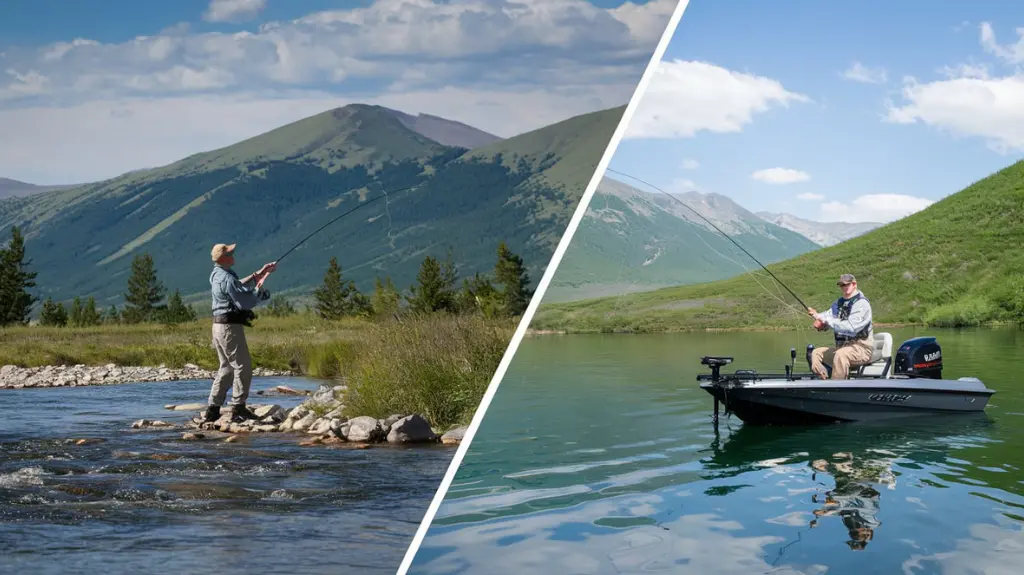In this article
Understanding what is fly fishing vs regular fishing reveals key differences in technique and equipment. While regular fishing relies on conventional rods with spinning reels, fly fishing uses specialized rods and weighted lines for artificial flies You’ll find regular fishing more versatile and beginner-friendly, suitable for various water bodies and fish species. Conversely, fly fishing requires more technical skills and works best for catching trout and salmon in streams and rivers, particularly during insect hatches. Both methods have unique advantages: regular fishing offers accessibility and quick results, whereas fly fishing develops specialized skills and environmental awareness. Comprehending these key differences will help you choose the perfect method for your angling adventures.
Summary
- Fly fishing uses specialized rods and weighted lines to cast artificial flies, while regular fishing employs conventional rods with spinning reels.
- Regular fishing is more beginner-friendly and versatile across different water bodies, while fly fishing requires more technical skill and practice.
- Fly fishing excels at catching trout and salmon during insect hatches, whereas regular fishing targets a broader range of fish species.
- Equipment differs significantly: fly fishing needs specific gear like long flexible rods and artificial flies; regular fishing uses simpler tackle.
- Regular fishing emphasizes practical catch rates, while fly fishing focuses on technique mastery and matching natural insect patterns.
Unraveling the Mysteries of Fly Fishing and Regular Fishing

Anyone who’s spent time around anglers knows there’s often a friendly rivalry between fly fishing and regular fishing enthusiasts.
Although both methods aim to catch fish, they employ distinctly different fishing techniques and fishing gear to achieve their goals. Comprehending these differences can help you choose the right approach for your fishing adventures.
Fly fishing involves using a specialized fly rod and weighted line to cast artificial flies that mimic insects and other natural prey. The technique requires precise casting skills and knowledge of insect life cycles, making it particularly effective for catching trout and salmon in streams and rivers.
Regular fishing, likewise known as bait fishing, uses conventional rods with spinning reels and relies on natural bait or artificial lures to attract target species. This versatile method works well in various water bodies and can catch a wider range of fish.
Your choice between these methods often depends on your preferred fishing lines, target species, and the type of fishing trip you’re planning. Fly fishing also offers the opportunity to target diverse species, including marine species such as redfish and tarpon, which can enhance the overall experience.
Each approach offers unique challenges and rewards, allowing anglers to develop different skills and explore various aspects of the sport.
What is Fly Fishing vs Regular Fishing: Demystifying the Core Differences

When you’re looking at fly fishing, you’ll find it’s a specialized technique using lightweight artificial flies and weighted lines to mimic natural insects and attract fish.
Regular fishing, in addition to being known as spin fishing, relies on traditional spinning reels, various lures, and live bait to catch a wider range of fish species.
These two distinct approaches require different gear and techniques, with fly fishing demanding more precise casting skills as regular fishing offers straightforward methods that work well in diverse fishing environments. Additionally, fly fishing often involves using specific fly patterns tailored to mimic various aquatic insects and baitfish, enhancing the effectiveness of the technique.
Fly Fishing Explained
Through specialized techniques and equipment, fly fishing stands apart from regular fishing in several fundamental ways. Unlike conventional fishing, which relies on weighted lures, fly fishing employs nearly weightless artificial flies that require a specialized casting technique to deliver them to the target.
When you’re fly fishing, you’ll need to master a distinct casting motion that employs the weight of the fishing line rather than the lure to reach your target. This precision casting approach demands practice but allows for delicate presentations that closely mimic natural insect behavior.
You’ll learn to present both dry flies that float on the surface and subsurface patterns that imitate aquatic insects.
One essential aspect of fly fishing is “matching the hatch,” where you’ll select artificial flies that closely resemble the insects currently active in the water. This attention to detail, combined with the need for accurate presentations, makes fly fishing more technically demanding than conventional methods. Additionally, utilizing casting techniques can significantly improve your success rate on the water.
Your success often depends on your ability to read the water, identify insect activity, and execute precise casts that fool various fish species.
Regular Fishing Explained
Regular fishing offers a more straightforward and versatile approach to angling compared to fly fishing’s technical demands. You’ll find such regular fishing employs a wide range of fishing rods, reels, and lures, making it adaptable for both freshwater species and saltwater fishing environments. Unlike fly fishing, regular fishing relies on weighted lures and fishing bait to achieve casting distance and reach desired depths.
The accessibility of regular fishing makes it an excellent choice for beginners and families. You’ll discover how fishing techniques are easier to master, as casting and retrieving methods are more intuitive than those used in fly fishing. Whether you’re using live bait or artificial lures, regular fishing focuses on practical approaches to catching fish. Such versatility allows anglers to adapt their strategies based on target species and fishing conditions, making it an effective method for both casual and serious fishermen. Additionally, regular fishing often employs various techniques to maximize catch rates across different environments.
Tackle Showdown: Understanding Fly Fishing vs Regular Fishing Equipment

When you’re comparing fly fishing and regular fishing equipment, you’ll notice significant differences in how the tackle is designed and used.
Your fly fishing setup will include specialized components like weight-forward lines, tapered leaders, and delicate flies which work together to achieve precise presentations.
Conversely, your regular fishing gear features more versatile equipment, including spinning reels, monofilament lines, and an array of lures or live bait options that can handle various fishing situations.
Fly Fishing Tackle
Fly fishing equipment differs fundamentally from conventional fishing gear, with five distinct components forming its core: the specialized rod, reel, weighted line, leader system, and artificial flies.
When you’re starting your fishing adventure, you’ll notice that fly rods are longer and more flexible than conventional fishing bait rods, typically ranging from 6 to 15 feet. The fly reel works differently too, functioning mainly as line storage with a straightforward drag system, whereas the weighted fly line is what carries your cast.
Here’s what makes fly fishing tackle unique:
- The leader and tippet system creates an almost invisible connection between your fly line and flies, helping you present your flies naturally to fish.
- Your artificial flies, whether they’re dry flies floating on top or wet flies swimming below, are crafted to precisely mimic natural prey.
- The fly line’s weight classification must match your rod’s specifications for ideal casting performance.
Understanding these components and how they work together is essential for successful fly fishing, as each piece serves a specific purpose in this specialized form of angling.
Regular Fishing Tackle
Unlike its fly fishing counterpart, traditional fishing tackle consists of simpler yet similarly effective equipment designed for casting weighted lures and natural bait.
You’ll find two main types of fishing gear: spinning rods and reels, which are perfect for beginners because of their ease of use, and baitcasting rods and reels, which offer more precision for experienced anglers.
Your success with regular fishing techniques depends heavily on your terminal tackle selection. These crucial components include hooks, sinkers, and bobbers which help you present your bait effectively in various fishing environments.
When choosing your setup, you’ll need to evaluate your target species and fishing conditions.
The versatility of regular fishing comes from its wide array of artificial lures and natural baits. You can select from countless options, from soft plastic worms for bass to live minnows for trout.
Each type of bait serves a specific purpose, allowing you to adapt to different situations. For instance, you might use weedless lures in vegetation-heavy areas or opt for bright spinners in clear water. Additionally, understanding the fishing line types can greatly enhance your overall fishing experience and effectiveness.
Exploring What is Fly Fishing vs Regular Fishing for Different Species

If you’re interested in pursuing trout and salmon, fly fishing thrives at mimicking their natural prey with artificial flies that match seasonal insect hatches. Regular fishing opens up opportunities to catch a wider variety of species, including bass, pike, and walleye, using an array of lures and live bait options. You’ll find that each method has its sweet spot, with fly fishing shining during specific insect emergence periods, whereas regular fishing remains effective throughout the year for multiple species across different water conditions. Additionally, trout are considered keystone species in aquatic ecosystems, playing a vital role in maintaining ecological balance.
What is Fly Fishing Best For?
Within the domain of targeting specific fish species, fly fishing flourishes in several distinct environments. As a successful fly fisherman, you’ll find that this technique outshines at catching freshwater game fish, particularly in rivers and streams where trout fishing dominates the scenery. Your artificial fly presentations can effectively mimic natural insects, making fly casting an incredibly productive method for fooling selective fish.
For fishing enthusiasts looking to maximize their fishing trips, fly fishing proves especially effective for:
- Cold-water species like trout and salmon in mountain streams, where precise presentation and delicate landings are essential
- Warmwater game fish such as bass and panfish in lakes and ponds, particularly during insect hatches
- Saltwater fly fishing opportunities targeting prestigious species like bonefish, permit, and tarpon in coastal waters
The versatility of fly fishing extends beyond just trout, though that remains its most celebrated application.
Whether you’re casting to rising fish in crystal-clear streams or pursuing aggressive predators in saltwater flats, fly fishing offers distinct advantages when matching natural prey patterns and presenting flies with finesse.
What is Regular Fishing Best For?
Regular fishing shines in situations where versatility and strength take precedence over delicate presentations. Unlike a fly fisherman who focuses on surface presentations, spin fishing outperforms in murky or deep water where fish caught are less selective about their prey.
You’ll find bait fishing techniques particularly effective when targeting a wider variety of fish species, from freshwater catfish to larger game fishing quarries.
You’ll appreciate how beginner-friendly regular fishing can be, making it an outstanding starting point for newcomers to the sport. The basic casting mechanics are straightforward to learn, and you won’t need the extensive practice required for fly fishing techniques.
Furthermore, efficiency and covering water quickly become significant advantages when you’re searching for active fish in larger bodies of water. With spin fishing, you can easily switch between different lures and presentations to adapt to changing conditions and fish behavior.
This adaptability allows you to effectively fish in various depths and water conditions, maximizing your chances of success across different species and environments.
Fly Fishing vs Regular Fishing Methods Explained

When you’re fly fishing, you’ll cast a weighted line with an artificial fly to mimic natural insects, requiring precise movements and specialized gear to present the fly naturally on the water’s surface.
In regular fishing, you’re using a simpler casting technique with a spinning reel to throw weighted lures or live bait, making it more straightforward to learn and practice.
Both methods can be effective, but you’ll find which fly fishing demands more technical skill and comprehension of insect patterns, whereas regular fishing offers more versatility in terms of locations and target species.
Fly Fishing Techniques
Modern fly fishing encompasses four main techniques which set it apart from conventional angling methods.
You’ll find dry fly fishing at the surface, where specialized flies imitate insects landing on the water to entice trout.
Wet fly fishing takes place below the surface, using sunken flies that mimic underwater creatures like nymphs and small bait fish.
Nymphing focuses on presenting weighted flies along the riverbed, often utilizing strike indicators to detect subtle takes from feeding fish.
Streamer fishing involves larger flies that imitate bait fish or leeches, typically retrieved with strips and pauses to trigger predatory responses.
When mastering these fishing techniques, you’ll want to contemplate:
- Water conditions and fish behavior, determine which technique will be most effective
- Seasonal patterns and insect hatches that influence your fly selection
- The specific species you’re targeting, as different fish respond better to certain techniques
Each method requires distinct presentation skills and comprehension of fish feeding habits.
You’ll need to adapt your approach based on conditions, selecting the right flies and techniques to match the situation at hand.
Regular Fishing Techniques
Throughout the domain of conventional fishing, anglers rely on four primary techniques that differ significantly from fly fishing methods.
Spin fishing, the most accessible of these fishing techniques, lets you cast and retrieve various lures using a spinning reel, making it perfect for catching predatory fish like bass and pike.
You’ll find baitcasting offers more control over your precision casts, utilizing a specialized reel that’s ideal for techniques like flipping and pitching into heavy cover.
When you’re targeting bottom-dwelling fish species, bottom fishing proves highly effective. This technique uses weighted fishing gear combined with live or cut bait to attract catfish and carp that feed near the lake or river bed.
If you’re looking to cover more water, trolling lets you drag lures or bait behind a moving boat, allowing you to search large areas for active fish. You can adjust your trolling speed and depth based on your target species, making it an adaptable approach for both freshwater and saltwater environments.
Each of these fishing techniques offers unique advantages depending on your target fish and fishing conditions.
Choosing Your Path: Which is Right for You?

If you’re drawn to the artistry of casting and don’t mind investing time in learning specialized techniques, fly fishing could be your perfect match.
Regular fishing might suit you better if you want a more versatile approach that works across different water bodies and fish species, with gear that’s typically more budget-friendly.
Your choice should align with your patience level, preferred fishing environment, and the type of fish you’re hoping to catch.
When to Choose Fly Fishing
Four key scenarios make fly fishing the ideal choice for anglers seeking specific experiences on the water. When you’re targeting surface-feeding fish, particularly trout feeding on aquatic insects, fly fishing’s ability to mimic natural prey makes it exceptionally effective.
In clear shallow water, the delicate presentation of flies creates less disturbance than traditional lures, improving your chances of success.
Three compelling reasons to choose fly fishing:
- You’ll experience a more engaging and challenging approach to angling through advanced casting techniques.
- You can better match natural prey patterns, especially during insect hatches.
- You’ll participate in conservation efforts through catch-and-release practices common in fly fishing.
The method’s emphasis on precise presentation and careful technique delivers a more hands-on fishing experience.
If you’re drawn to the art of presentation and enjoy developing specialized skills, fly fishing offers a rewarding challenge. The focus on conservation through catch and release practices equally makes it an excellent choice for environmentally conscious anglers who want to preserve fish populations for future generations.
When to Choose Regular Fishing
Regular fishing shines in specific situations where its versatility and straightforward approach make it the ideal choice. When you’re targeting fish in deep or murky waters, regular fishing techniques like spin fishing and bait fishing excel where fly fishing can’t reach. You’ll find that coarse fishing methods allow you to cover more water effectively, increasing your chances of success.
If you’re just starting, regular fishing methods offer greater ease of use and accessibility. The basic casting techniques are simpler to achieve, and you won’t need as much specialized equipment. Regular fishing techniques likewise give you the flexibility to target a wider range of species, from surface-feeding bass to bottom-dwelling catfish. When you’re fishing in large bodies of water or need to cover extensive areas quickly, traditional fishing methods provide the versatility you need. The straightforward nature of regular fishing makes it particularly appealing for beginners who want to focus on catching fish rather than perfecting complex techniques.
Final Thoughts
Both fly fishing and regular fishing carve out their special places in the angling world, and you don’t need to pick just one. Your fishing goals and target species will often guide your choice, but experimenting with both methods will make you a more versatile angler.
Before planning your fishing trips, check local fishing regulations and invest in quality gear that suits your preferred technique.
Success in either method comes down to three crucial elements:
- Comprehending your local fish species and their habitats helps you choose the right spots and times to fish.
- Perfecting fundamental casting techniques through consistent practice and patience.
- Learning from experienced anglers who can share precious insights about both fly fishing and regular fishing approaches.
Whether you’re drawn to the artistry of fly fishing or the accessibility of regular fishing, both methods offer rewarding experiences.
Take time to develop your skills in each style, and you’ll discover that having both options in your angling arsenal enhances your overall fishing experience.
Keep in mind, that there’s no wrong choice – it’s about finding what works best for you.
Popular Questions
What’s Better, Fly Fishing Vs Regular Fishing?
What Makes a Good Fly Fishing Guide?
What Are the Disadvantages of Fly Fishing?
What Is the Difference Between Fly Fishing and Casting?
We are a participant in the Amazon Services LLC Associates Program, an affiliate advertising program designed to provide a means for sites to earn advertising fees by advertising and linking to Amazon.com. As an Amazon Associate I earn from qualifying purchases. We also participate in other affiliate programs. The information provided on this website is provided for entertainment purposes only. We make no representations or warranties of any kind, expressed or implied, about the completeness, accuracy, adequacy, legality, usefulness, reliability, suitability, or availability of the information, or about anything else. Any reliance you place on the information is therefore strictly at your own risk. Additional terms are found in the terms of service.









